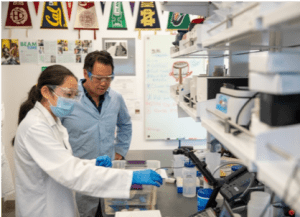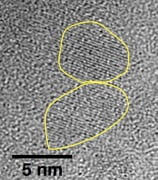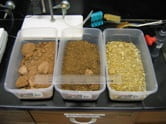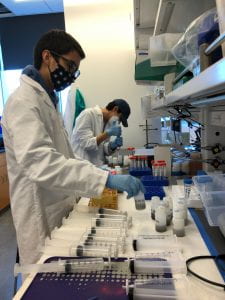The Environmental Geochemistry Lab conducts research in a number of areas. Please read on to learn about various ongoing projects in the lab; contact Dr. Christopher Kim for more information.
Heavy Metal Sequestration by Iron Oxyhydroxide Nanoparticles
Iron oxyhydroxides are among the most common and reactive natural phases found in the environment with respect to metal uptake. Increasingly, particles at the nanometer (10-9 m) scale have been recognized as having chemical and physical properties that vary dramatically relative to larger particles. Thus, the study and manipulation of these nanoparticles for remediative purposes can improve our understanding of natural environmental processes and inform future technologies to enhance metal removal from contaminated aqueous systems. Projects in this area include:
-
Concentration- and pH-based metal uptake onto nanoparticles as a function of size

-
Heavy metal structural incorporation into nanoparticles with aging at elevated temperatures
-
Aggregation of and metal uptake on nanoparticles as a function of pH and ionic strength
-
Effects of drying and freezing on nanoparticle aggregation and metal uptake
Characterizing the Speciation, Distribution, and Correlation of Heavy Metals in Mine Wastes
Decades of mining in California have left a legacy of metal-contaminated mine wastes across the world’s mineralized regions. These wastes often contain elevated levels of many hazardous metals in addition to the primary ore metal. Understanding trends in metal concentrations, metal speciation (the dominant chemical form of the metal), and correlations between metals as afunction of particle size will provide insight into the mechanical and chemical processes that distribute metals in the environment and impact their availability to living organisms.
Collaborations with individuals at the US Geological Survey and the Bureau of Land Management allow access to sites for sampling, with size separation conducted at Chapman. Further analysis involves techniques available at X-ray synchrotron facilities, which can provide detailed structural and chemical information at relatively low concentrations.
Metal Availability in Mine Wastes Through Leach Studies
While total metal concentration is an important factor in assessing the hazard level of a contaminated waste, it is the fraction that can be leached, or removed from the solid phase and mobilized in solution, that may largely dictate the bioavailability of the metal in natural systems. Lab-based leaching tests can help assess such availability, with different size fractions of previously-separated mine waste exposed to different solutions to simulate surface water interactions and human ingestion/inhalation. Currently leach tests are underway with the following leachates:
-
Deionized water
-
Simulated gastric fluid (SGF)
-
Simulated lung fluid (SLF)
-
Phagolysosomal simulate fluid (PSF)


